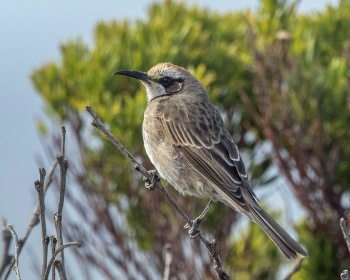m |
(All sections now started. References. Incomplete gone) |
||
| (10 intermediate revisions by 6 users not shown) | |||
| Line 1: | Line 1: | ||
| − | + | [[Image:Tawny-crowned_Honeyeater.jpg|thumb|450px|right|Photo © by {{user|Neil|Neil fifer}}<br />Sydney, [[Australia]], July 2006]] | |
| − | [[Image:Tawny-crowned_Honeyeater.jpg|thumb| | + | ;[[:category:Gliciphila|Gliciphila]] melanops |
| + | ''Phylidonyris melanops'' | ||
==Identification== | ==Identification== | ||
| − | Photo | + | [[Image:1365 Honeyeater, Tawny-crowned 01m.jpg|thumb|350px|right|Photo © by {{user|peterday|Peter Day}}<br />Kangaroo Island, [[South Australia]], March 2017]] |
| + | 14–18 cm (5½-7 in) | ||
| + | *Cinnamon crown | ||
| + | *White forehead and [[Topography#Heads|supercilium]] | ||
| + | *Black mask through the eye and extending down the neck sides to the breast | ||
| + | *White throat | ||
| + | *Greyish-brown upperparts | ||
| + | *Olive-brown streaks and mottling on mantle and back | ||
| + | *White underparts | ||
| + | |||
| + | ==Distribution== | ||
| + | Endemic to [[Australia]]. | ||
| + | ==Taxonomy== | ||
| + | Formerly placed in genus [[:category:Phylidonyris|Phylidonyris]]. | ||
| + | ====Subspecies==== | ||
| + | There are 2 ubspecies<sup>[[#References|[1]]]</sup>: | ||
| + | *''G. m. melanops'': | ||
| + | :*North East [[New South Wales]] to south-eastern [[South Australia]], eastern [[Tasmania]] and south-western [[Western Australia]] | ||
| + | *''G. m. chelidonia'': | ||
| + | :*Western [[Tasmania]] | ||
| + | ==Habitat== | ||
| + | Coastal and inland dryish heaths and low woodland. | ||
| + | ==Behaviour== | ||
| + | ====Diet==== | ||
| + | Their main diet consists of nectar taken from a wide variety of flowering shrubs. They also eat insects, often taken in flight. | ||
| + | ====Breeding==== | ||
| + | They construct a strong cup nest from twigs, strips of bark and grass. It is lined with with soft material such as plant down, wool and fur. It is placed in a clump of grass or low in a dense bush. The clutch is thought to contain or 2 or three eggs. | ||
| + | ==References== | ||
| + | #{{Ref-Clements6thAug18}}#Handbook of the Birds of the World Alive (retrieved October 2018) | ||
| + | #Adelaide and Mount Lofty Ranges species sheet | ||
| + | {{ref}} | ||
==External Links== | ==External Links== | ||
| − | + | {{GSearch|Gliciphila+melanops}} | |
| − | [[Category:Birds]] | + | [[Category:Birds]] [[category:Gliciphila]] |
Latest revision as of 21:46, 11 October 2018
- Gliciphila melanops
Phylidonyris melanops
Identification
14–18 cm (5½-7 in)
- Cinnamon crown
- White forehead and supercilium
- Black mask through the eye and extending down the neck sides to the breast
- White throat
- Greyish-brown upperparts
- Olive-brown streaks and mottling on mantle and back
- White underparts
Distribution
Endemic to Australia.
Taxonomy
Formerly placed in genus Phylidonyris.
Subspecies
There are 2 ubspecies[1]:
- G. m. melanops:
- North East New South Wales to south-eastern South Australia, eastern Tasmania and south-western Western Australia
- G. m. chelidonia:
- Western Tasmania
Habitat
Coastal and inland dryish heaths and low woodland.
Behaviour
Diet
Their main diet consists of nectar taken from a wide variety of flowering shrubs. They also eat insects, often taken in flight.
Breeding
They construct a strong cup nest from twigs, strips of bark and grass. It is lined with with soft material such as plant down, wool and fur. It is placed in a clump of grass or low in a dense bush. The clutch is thought to contain or 2 or three eggs.
References
- Clements, J. F., T. S. Schulenberg, M. J. Iliff, D. Roberson, T. A. Fredericks, B. L. Sullivan, and C. L. Wood. 2018. The eBird/Clements checklist of birds of the world: v2018. Downloaded from http://www.birds.cornell.edu/clementschecklist/download/
- Handbook of the Birds of the World Alive (retrieved October 2018)
- Adelaide and Mount Lofty Ranges species sheet
Recommended Citation
- BirdForum Opus contributors. (2024) Tawny-crowned Honeyeater. In: BirdForum, the forum for wild birds and birding. Retrieved 26 May 2024 from https://www.birdforum.net/opus/Tawny-crowned_Honeyeater





